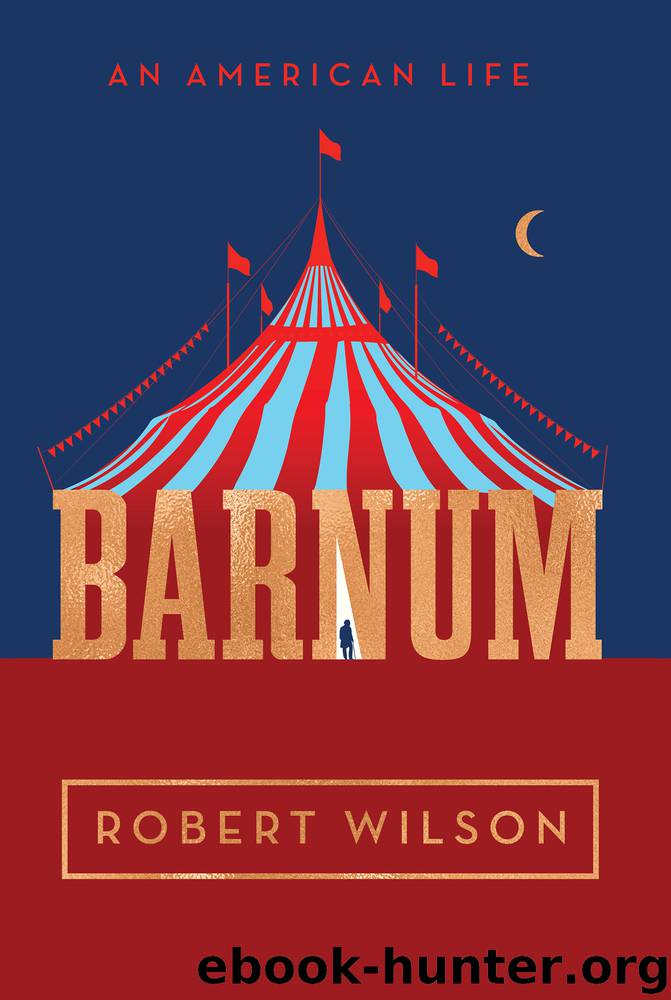Barnum by Robert Wilson

Author:Robert Wilson
Language: eng
Format: epub
Publisher: Simon & Schuster
Published: 2019-08-05T16:00:00+00:00
THIRTEEN
* * *
* * *
A RUINED MAN
After the Jenny Lind tour ended, Barnum briefly but seriously considered moving the family to Philadelphia, where he owned a museum and a country house, but between them Charity and Caroline persuaded him to stay in Fairfield. With that, he redoubled his commitment to his adopted hometown, involving himself in an ambitious real-estate development project in adjacent Bridgeport that would draw more on his energy and his wealth than his wisdom.
Across the Pequonnock River from Bridgeport lay what Barnum called a “beautiful plateau” and what an early travel writer named Timothy Dwight IV called a “cheerful and elegant piece of ground,” the “surrounding country . . . gay and brilliant, perhaps without a parallel.” At the time the travel piece was written, about 1815, Bridgeport consisted of a hundred houses situated on both sides of the Pequonnock, near its mouth. The bridge connecting them gave the village its name. The eastern portion of the community did not develop over time as the western portion had, something Barnum blamed on “want of means of access” to the beautiful plateau. He decided to solve the problem directly, and with a prominent attorney in the town, William H. Noble, set about creating on this fine piece of land the new city of East Bridgeport. Noble had inherited a fifty-acre homestead on the eastern bank of the river, half of which Barnum bought for $20,000 on the last day of October 1851. Together the two men quietly purchased another 174 acres of adjacent land, and then set about, in conjunction with the city of Bridgeport, building a series of new bridges across the river. Barnum and Noble quickly laid out a grid of tree-lined streets on their property and marked off lots for residences and businesses. At the heart of the new city would be a six- to eight-acre grove of trees preserved as Washington Park. (To this day, Barnum Avenue and Noble Avenue cross at the northwest corner of the park.) Soon they began selling the lots at cost, keeping every other one for themselves, expecting to make their money when the value of the lots increased. If that were not enough, they also lent the new landowners the money to buy the land and build on it, allowing them to draw down their debts in irregular payments as small as $5.1
This remarkable deal had a few stipulations: the property must be developed within a year, the style of the houses and buildings had to meet with their approval and be situated back from the street, and the lots must be surrounded by fences and kept tidy. Barnum did not say where the ideas behind these restrictions came from, but the general principles by which they developed their new city anticipated by half a century those of the Garden City movement in England and the City Beautiful movement in the United States. The principles also resemble the ideals of the New Urbanism movement that began in the United States in the 1980s.
Download
This site does not store any files on its server. We only index and link to content provided by other sites. Please contact the content providers to delete copyright contents if any and email us, we'll remove relevant links or contents immediately.
| Africa | Asia |
| Canadian | Europe |
| Holocaust | Latin America |
| Middle East | United States |
Fanny Burney by Claire Harman(26506)
Empire of the Sikhs by Patwant Singh(22958)
Out of India by Michael Foss(16776)
Leonardo da Vinci by Walter Isaacson(13140)
Small Great Things by Jodi Picoult(6950)
The Six Wives Of Henry VIII (WOMEN IN HISTORY) by Fraser Antonia(5379)
The Wind in My Hair by Masih Alinejad(5022)
A Higher Loyalty: Truth, Lies, and Leadership by James Comey(4820)
The Lonely City by Olivia Laing(4730)
The Crown by Robert Lacey(4709)
Millionaire: The Philanderer, Gambler, and Duelist Who Invented Modern Finance by Janet Gleeson(4350)
The Iron Duke by The Iron Duke(4269)
Papillon (English) by Henri Charrière(4174)
Sticky Fingers by Joe Hagan(4083)
Joan of Arc by Mary Gordon(4000)
Alive: The Story of the Andes Survivors by Piers Paul Read(3953)
Stalin by Stephen Kotkin(3862)
Aleister Crowley: The Biography by Tobias Churton(3570)
Ants Among Elephants by Sujatha Gidla(3399)
